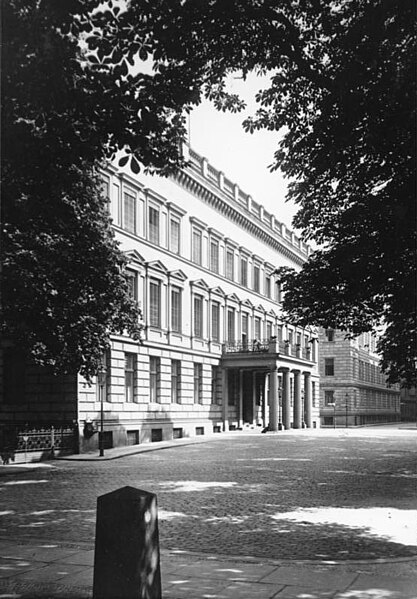Johann Philipp Graumann was a German business mathematician, an expert on exchange rates and coinage, mint master in Braunschweig-Wolfenbüttel and Berlin, a mercantilist, and Prussian financial advisor. He is considered one of the most important German monetary theorists of his time. As master of the mints in Prussia, he implemented a major coin reform, with the goal of implementing a new monetary standard to promote trade, increase seigniorage income and elevate the Prussian coins to the status of a reserve currency. Graumann was portrayed by his contemporaries as a dreamer. With only a slight modification, his coin standard remained in place in Germany until 1907.
In the 18th century half of the Palais am Festungsgraben was occupied by J.P. Graumann; Prussian Ministry of Finance in the 1930s.
In the middle the Friedrichswerder city counsel (nr. 25) can be seen. To the north along the Spreekanal and the Unterwasserstrasse, was the old mint. Detail Berliner Stadtansicht von Schultz, 1688.
8 Gute Groschen (⅓ Reichstaler) von 1754, Münzzeichen: A, Münzstätte Berlin
A Münzfuß is an historical term, used especially in the Holy Roman Empire, for an official minting or coinage standard that determines how many coins of a given type were to be struck from a specified unit of weight of precious metal. The Münzfuß, or Fuß ("foot") for short in numismatics, determined a coin's fineness, i.e. how much of a precious metal it would contain. Mintmaster Julian Eberhard Volckmar Claus defined the standard in his 1753 work, Kurzgefaßte Anleitung zum Probieren und Münzen, as follows: "The appropriate proportion of metals and the weight of the coin, measured according to their internal and external worth, or determined according to their quality, additives and fineness, number and weight, is called the Münzfuß."
Coin standard (14 Thaler standard) on an 1846 Hanoverian Thaler




